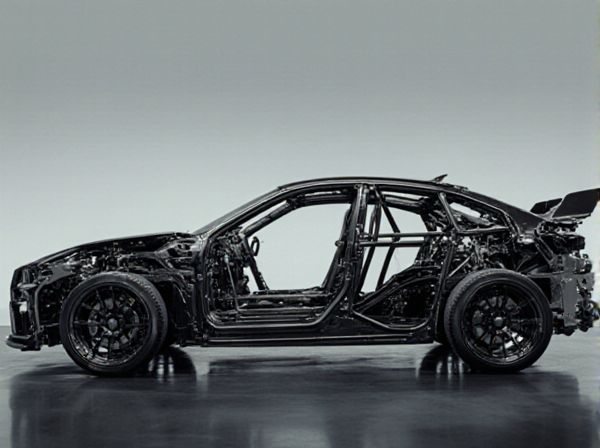
Photo illustration: Monocoque vs Body-on-Frame
Monocoque construction integrates the vehicle's body and frame into a single unit, offering enhanced rigidity and reduced weight, which improves fuel efficiency and handling. Body-on-frame design involves mounting the body onto a separate chassis, providing superior durability and easier repair for heavy-duty or off-road use. Your choice depends on whether you prioritize performance and comfort or strength and versatility.
Table of Comparison
| Feature | Monocoque | Body-on-Frame |
|---|---|---|
| Structure | Integrated chassis and body | Separate frame and body |
| Weight | Lighter, improves fuel efficiency | Heavier, reduces efficiency |
| Strength | Good for passenger cars | Superior for heavy-duty use |
| Safety | Better crash energy absorption | Less effective in crash energy management |
| Manufacturing Cost | Higher due to complexity | Lower, simpler assembly |
| Repairability | Challenging, requires specialized tools | Easier, individual parts can be replaced |
| Common Use | Passenger cars, SUVs | Trucks, off-road vehicles, large SUVs |
Understanding Monocoque and Body-on-Frame Designs
Monocoque design integrates the vehicle's body and chassis into a single, unified structure, enhancing rigidity and reducing weight for improved fuel efficiency and handling. Body-on-frame construction separates the vehicle's body from the frame, offering superior durability and easier repairs, common in trucks and SUVs for heavy-duty use. Understanding these designs helps in selecting the right vehicle based on performance needs, weight considerations, and intended use.
Historical Evolution of Vehicle Chassis
The historical evolution of vehicle chassis reveals a transition from traditional body-on-frame designs, prevalent in early automobiles and trucks due to their durability and ease of repair, to modern monocoque structures that integrate the body and frame into a single unit. Body-on-frame chassis dominated the automotive industry through the early to mid-20th century, favored for heavy-duty applications and off-road vehicles. The rise of monocoque construction in the late 20th century brought advancements in vehicle weight reduction, safety, and fuel efficiency, driving its widespread adoption in passenger cars and light trucks.
Structural Differences: Monocoque vs Body-on-Frame
Monocoque construction integrates the vehicle's body and chassis into a single unit, enhancing rigidity and reducing weight for improved fuel efficiency and handling. In contrast, body-on-frame design separates the frame as a distinct, heavy-duty structure that supports the body, offering superior durability and ease of repair for off-road and heavy-load applications. These structural differences impact vehicle performance, safety, and manufacturing complexity across automotive platforms.
Performance and Handling Characteristics
Monocoque construction offers superior rigidity and lighter weight, enhancing acceleration, cornering precision, and fuel efficiency compared to body-on-frame designs. Body-on-frame vehicles provide better durability and off-road capability but often compromise handling responsiveness and stability due to higher weight and flex. The choice between monocoque and body-on-frame significantly impacts vehicle dynamics, with monocoque favored in sports and passenger cars for agility, while body-on-frame suits trucks and SUVs requiring rugged performance.
Safety Considerations in Both Designs
Monocoque construction integrates the vehicle's body and frame into a single unit, providing enhanced crash energy absorption and improved occupant protection due to its rigid structure. Body-on-frame designs offer superior durability and easier repair after collisions but may transfer impact forces less effectively, potentially increasing occupant risk in severe crashes. Safety considerations favor monocoque vehicles for passenger cars due to better crashworthiness, while body-on-frame remains prevalent in trucks and SUVs for functional load-bearing capacity.
Weight, Efficiency, and Fuel Economy
Monocoque construction typically offers lighter vehicle weight compared to body-on-frame designs, enhancing overall fuel efficiency by reducing mass. The integrated structure of monocoque improves aerodynamic performance, contributing to better mileage and energy use. Conversely, body-on-frame vehicles are heavier but provide superior durability and off-road capability, often resulting in lower fuel economy.
Manufacturing Complexity and Costs
Monocoque construction integrates the vehicle's body and frame into a single unit, reducing manufacturing complexity and material costs by eliminating the need for separate chassis fabrication. Body-on-frame design requires assembling a distinct frame and attaching the body, increasing labor intensity and production expenses due to additional welding and mounting processes. The streamlined monocoque approach enhances production efficiency, while body-on-frame construction offers greater flexibility at the expense of higher manufacturing complexity and costs.
Off-Road and Utility Applications
Monocoque construction offers enhanced rigidity and reduced weight, improving fuel efficiency and on-road handling but typically lacks the durability required for extreme off-road conditions. Body-on-frame design excels in off-road and utility applications due to its superior strength, ease of repair, and ability to endure heavy loads and rough terrain. In rugged environments, vehicles with body-on-frame construction provide better torsional flexibility and higher ground clearance, essential for tackling challenging landscapes and towing demands.
Common Vehicles Using Each Technology
Monocoque construction is predominantly used in modern passenger cars such as the Toyota Camry, Honda Civic, and Tesla Model 3 for its lightweight and improved fuel efficiency. Body-on-frame design remains common in trucks and SUVs like the Ford F-150, Toyota Land Cruiser, and Jeep Wrangler, offering superior durability and off-road capability. Commercial vehicles and heavy-duty trucks also favor body-on-frame structures for enhanced load-bearing capacity and easier repair.
Future Trends in Automotive Chassis Engineering
Future trends in automotive chassis engineering emphasize the rise of lightweight monocoque structures due to their superior rigidity, safety, and fuel efficiency compared to traditional body-on-frame designs. Advances in materials like carbon fiber composites and aluminum alloys are driving innovation in monocoque chassis, enabling enhanced crash performance and weight reduction. Electric vehicle integration further accelerates the shift, as monocoque platforms better accommodate battery packs and electric drivetrains, promoting improved structural integrity and vehicle dynamics.
 caratoz.com
caratoz.com